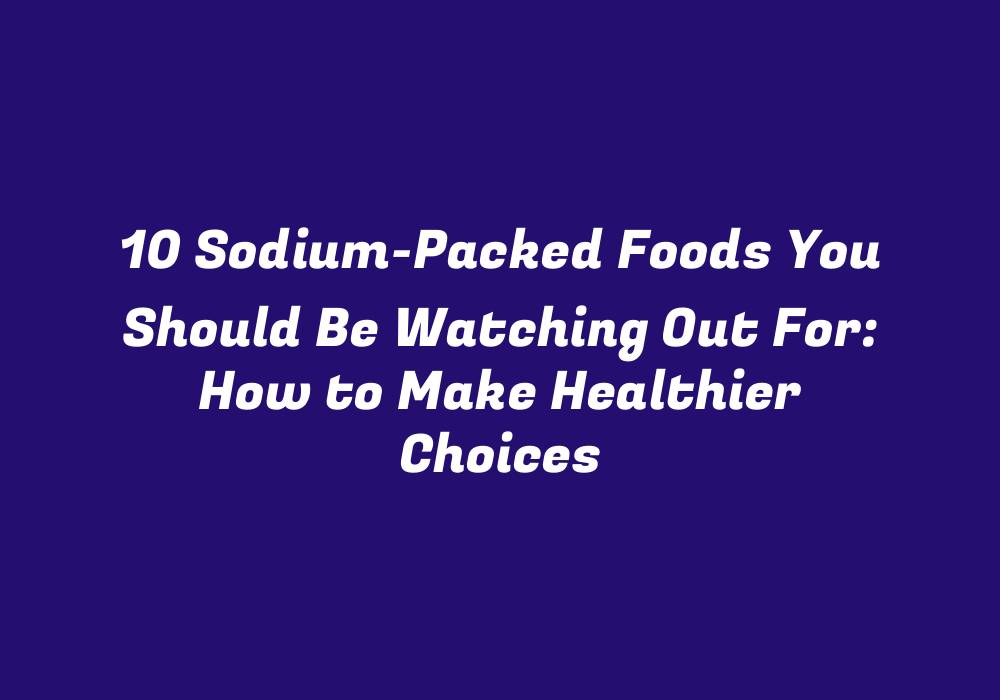10 Sodium-Packed Foods You Should Be Watching Out For: How to Make Healthier Choices
Sodium is an essential mineral for the human body, but too much of it can lead to a multitude of health issues. Incorporating foods with low sodium content into your daily diet can help reduce the risk of hypertension, heart disease, and kidney-related problems. Here are 10 sodium-packed foods you should be watching out for in order to make better choices when it comes to maintaining a healthier lifestyle.
Fast Food
Fast food restaurants have gained popularity due to their convenience and relatively low prices. However, they often offer meals with high sodium content. From burgers with salt-rich ingredients like processed cheese and bacon to French fries cooked in salted oil, fast food establishments abound with sodium-laden menu options.
Processed Meats
Meat products such as ham, sausages, deli meats, and cold cuts often contain a high amount of salt for preservation. While this can help keep them fresh longer, it is crucial to minimize their consumption due to the increased risk of heart diseases associated with excess sodium intake.
Canned Foods
The majority of canned foods contain a significant amount of sodium, especially those that are prepared in brine or packaged along with salted ingredients. Tomato sauces, soups, and veggies are some examples of canned food items to be cautious about when selecting low-sodium options.
Bread and Baked Goods
Many bakery items, including bread and pastries, contain a substantial amount of salt. The dough is often enhanced with it for taste and texture purposes, so be mindful when selecting whole grain or low-sodium varieties to reduce sodium intake.
Pickles
Although pickles are a good source of fiber and vitamins, they are typically brined in salt. This means that each serving contains quite a bit of the mineral. Opt for fermented or naturally-brined pickles instead to decrease sodium intake without sacrificing the delicious crunchy texture.
Chips and Crackers
Crackers and chips are often made with processed, salted ingredients. Their preparation involves frying or baking in high-sodium oils which can lead to a substantial sodium content in the final product. While these snacks may be tempting, consider consuming them in moderation and choosing healthier alternatives like air-popped popcorn or unsalted nuts.
Canned Soups
While homemade soups can be prepared with low sodium content, canned soups often contain excessive amounts of salt. Many brands use high levels of sodium to enhance taste and extend shelf life. Opt for lower-sodium soup varieties or make your own at home using fresh ingredients.
Takeout and Restaurant Food
Food from takeout and restaurants often contains hidden sources of salt, making it challenging to control sodium intake. In many cases, sauces, marinades, and garnishes are loaded with extra sodium to boost flavor. Try ordering dishes prepared without added salt or opt for options like steamed vegetables or grilled meats to minimize sodium consumption.
Pre-Made Sauces
Prepared sauces, marinades, and salad dressings can be loaded with salt. Choose lower-sodium alternatives, such as vinegar-based dressings or homemade sauces prepared from scratch to cut back on added sodium.
Frozen Meals
Many frozen meals are high in sodium due to their long shelf life and convenience. When choosing frozen options, opt for those labeled “low-sodium” or focus on healthier alternatives such as homemade versions containing fewer processed ingredients.
In conclusion, adopting a more mindful approach when selecting food can help you make healthier choices that reduce your sodium intake. By being aware of the foods with high salt content and seeking out lower-sodium options, you can better manage your overall well-being and minimize the risk of hypertension and other chronic diseases associated with excessive sodium consumption.
